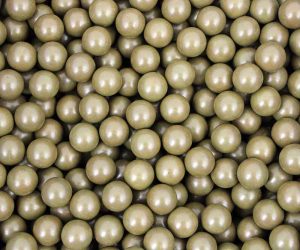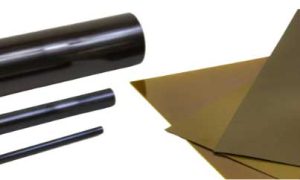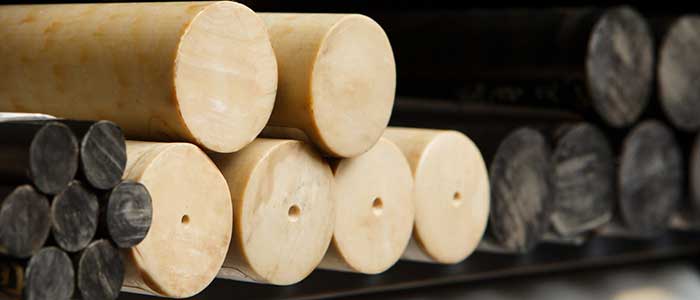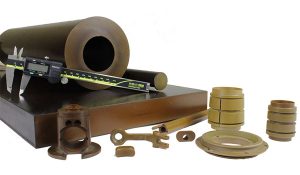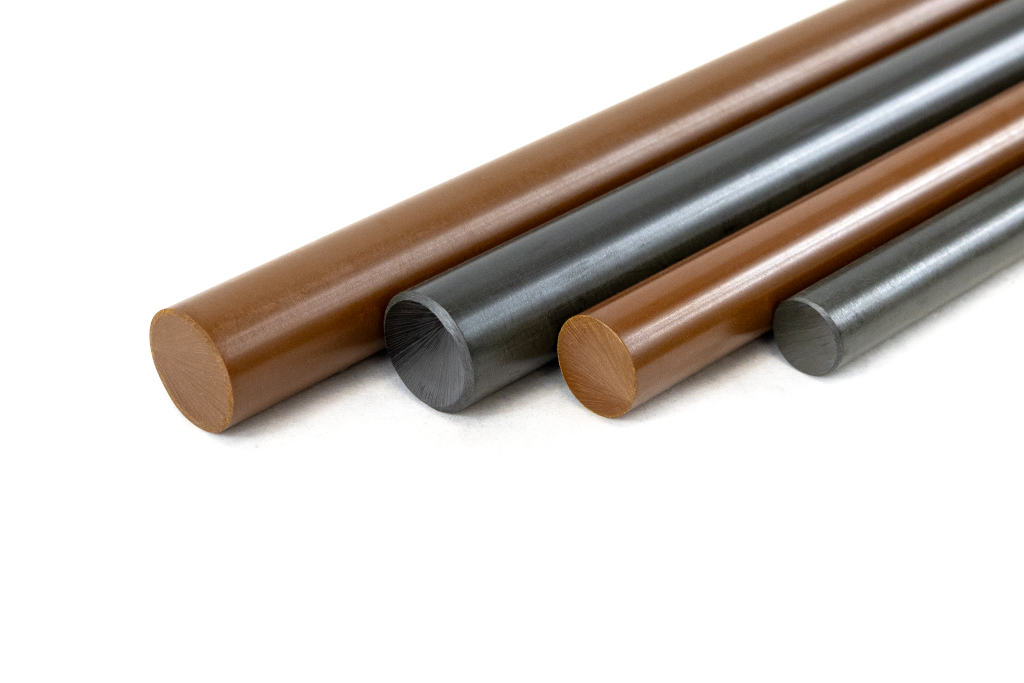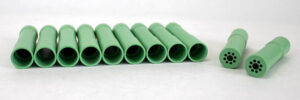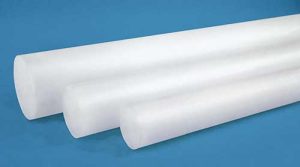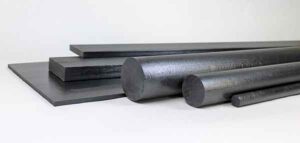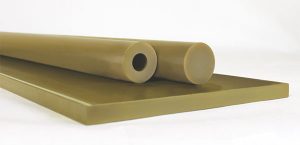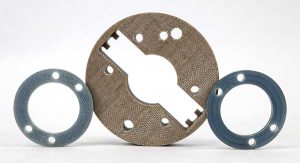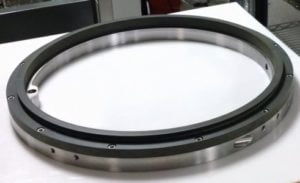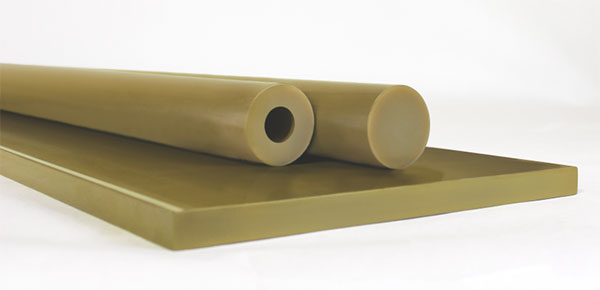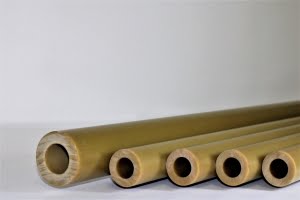What is Ultem 2400 PEI?
Ultem 2400 PEI is a polyetherimide amorphous plastic that is reinforced with 40% glass fiber content. The resin itself is opaque and dark amber in its standard form, and is available in custom colors. It is also RoHS compliant.
All grades within the Ultem polyetherimide family have intrinsically high structural strength, stiffness, flame-resistant properties and resistance to high temperatures and chemicals. These same attributes characterize other imidized polymers such as Torlon PAI, a polyamide-imide, and Vespel PI, a polyimide, to different degrees. The addition of 40% glass fiber reinforcement gives Ultem 2400 much higher strength than unfilled grades of Ultem PEI, and a significant improvement in strength over grades with a lower glass fiber content.
What types of semi-finished shapes for machining are available in Ultem 2400?
Drake Plastics processes the PEI material by melt extrusion into a wide range of semi-finished rod and plate sizes for machining. The thermoplastic can also be melt-processed into parts by injection molding. Ultem 2300, a similar grade reinforced with 30% glass fiber content, is also available from Drake in the form of extruded Seamless Tube®.
What are the key properties of Ultem 2400?
The 40% glass-fiber content of the Ultem 2400 formulation adds significant structural strength to Ultem PEI’s inherent and exceptional combination of properties. This makes it a lightweight, durable option as a replacement for metal.
Ultem 2400 maintains high structural strength at high temperatures.
The ability to maintain structural rigidity and resist creep at elevated temperatures are major performance benefits of Ultem 2400. The 40% glass-reinforced formulation’s flexural modulus measures 10,000 MPa (1,450 Kpsi) and it remains at this high level at temperatures of over 200oC (392oF). It heat resistance makes it a viable lightweight alternative to metals for many machined components that must remain stable and rigid in high-temperature environments.
Data sheet properties of Ultem 2400 show an impressive 210oC (410oF) heat deflection temperature when test bars are subjected to 1.8MPa (261 psi). An amorphous polymer, it also has a higher glass transition temperature (Tg) or softening point of 217oC (422oF), compared to that of semi-crystalline PEEK at 150oC (302oF).
Flammability resistance of Ultem 2400 meets UL V0 and FAR25.853 standards.
The Ultem PEI polymer is intrinsically flame retardant without the addition of flame retardant additives. Its flame and smoke test characteristics have gained glass-reinforced Ultem 2400 certification to a UL 94V0 rating, and compliance with the performance criteria of the aviation industry’s FAR25.853 standard. It also has an impressive oxygen index of 54% as measured by ASTM D 2863.
Ultem 2400 offers exceptional and stable electrical properties.
Ultem 2400 dielectric strength is among the highest of any commercially available thermoplastic. The electrical properties of all Ultem formulations including their volume resistivity and dissipation factor remain stable over a wide range of conditions. These properties along with its thermal and mechanical performance and its flammability ratings have led to specifications for Ultem 2400 in critical electrical and electronic components used in aerospace and other high technology equipment.
Ultem 2400 resists more chemicals than many other amorphous plastics.
Compared to other amorphous polymers, Ultem PEI withstands exposure to an exceptionally wide range of chemicals. The Ultem 2400 resin formulation maintains physical properties and resists environmental stress cracking under exposure to most commercial automotive and aircraft fluids, fully halogenated hydrocarbons, alcohols and weak aqueous solutions. However, products made from the material should not be used where they are exposed to partially halogenated hydrocarbons and in strong alkaline environments.
As with all materials, when applications of Ultem 2400 require prolonged exposure to or immersion in a specific chemical, finished parts must be evaluated under actual in-use conditions.
Low moisture absorption and CLTE afford dimensionally stable Ultem 2400 parts.
In wet and humid environments, components machined from Drake’s Ultem 2400 semi-finished shapes exhibit high dimensional stability. Key factors are the material’s low water absorption of 0.8% at saturation, and its low moisture absorption of 0.4% at 50% relative humidity. The high performance plastic also retains its properties after repeated steam sterilization, which makes it a candidate for medical applications where a machined or molded product requires high structural strength and long term reliability.
What other performance benefits does Ultem 2400 offer?
The Ultem 2400 PEI 40% glass-reinforced grade has additional features that have led to its specification by the engineering community in highly diverse applications.
Because it can be electroplated, Ultem 2400 has been specified for high intensity lamp housings for both the automotive and aircraft industries. Its strength at elevated temperatures ensures the structural integrity of these components.
In addition, the material is not known to impart contaminants or impurities under high temperature conditions. Among the related attributes of Ultem 2400 in this regard are low ionics and low outgassing. No PFAs are intentionally added to the material, and it contains no halogenated flame retardant additives.
How Drake optimizes Ultem 2400 properties in machined parts.
The orientation of fibers within an extruded semi-finished shape is determined by the flow direction of the melted material during processing. Further, fiber orientation in machined parts affects both their dimensional stability, and where the highest levels of strength will reside in the part’s configuration.
An important property related to dimensional stability is the polymer formulation’s CLTE, or coefficient of linear thermal expansion. How fiber orientation affects CLTE can be a key consideration when designing and machining parts. This is especially the case for components machined from Ultem 2400, with its high glass fiber content of 40%.
As an example, the CLTE or coefficient of liner thermal expansion of Ultem 2400 in the direction of melt flow measures 1.5 x 10-5/oC. When measured across the direction of flow, CLTE increases to 4.5 x 10-5/oC.
Similarly, strength-related properties and especially flexural modulus are affected by fiber orientation within the machined part. Physical property measurements taken in the direction of flow show higher values than those exhibited in the cross-flow direction.
Drake Plastics has extensive experience in optimizing strength and stability properties based on fiber orientation in semi-finished extruded shapes and in parts machined from them. In many cases, this expertise allows Drake to position the rod or plate to be machined so that the internal fiber orientation imparts the highest strength where it is most required.
What are typical applications of Ultem 2400?
Engineers and designers have specified Ultem 2400 for structural components requiring dimensional stability, environmental resistance and compliance with industry flammability and smoke generation standards. Current and potential applications cover diverse industries and include:
- Aircraft lighting and seating components
- Electrical and electronic equipment components
- Wiring devices and connectors including those in oil field equipment
- Circuit protection components
- Healthcare apparatus and imaging equipment
- Liquid metering, oil processing equipment
- Sterilizable medical instruments and device components
